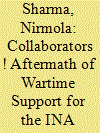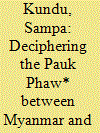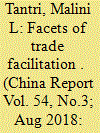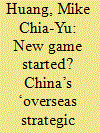|
|
|
Sort Order |
|
|
|
Items / Page
|
|
|
|
|
|
|
| Srl | Item |
| 1 |
ID:
160497


|
|
|
|
|
| Summary/Abstract |
Since Vietnam and China normalised their ties in 1991, high-ranking leaders of the two countries have arrived at a common awareness on various issues with a view to promoting a relationship based on friendship, equality and mutual benefit. However, in reality, a big gap still exists between awareness and practice. There is a certain ‘phase deviation’, which leads to differences in assessment and approaches to the development of bilateral relations. Two-way trade has developed in a fast but imbalanced manner. China’s direct investments in Vietnam have not been on par with its potential. Many projects have been contracted, but a number of issues in terms of quality, technology and environmental protection have surfaced. Two out of three territorial and border issues have been settled, but the one concerning the Biển Ðông (the East Sea, or South China Sea) has become increasingly complicated. At present, the Vietnam–China relationship has entered a new phase of development with new requirements and demands as well as new opportunities and challenges.
|
|
|
|
|
|
|
|
|
|
|
|
|
|
|
|
| 2 |
ID:
160498


|
|
|
|
|
| Summary/Abstract |
This article discusses the plight of the Indian community in China after the World War II. During the World War II, a sizeable number of Indian immigrants in China had been mobilised under the banner of the Indian National Army (INA), which was fighting for freedom from British colonial rule in alliance with Japan. This article seeks to understand the complex problems faced by the Indians in China in the aftermath of the War both because of the general dislocation they had suffered on account of war and occupation, and also because of their active or passive participation in a movement seen as ‘collaborationist’. It looks at how, for the British, Chinese and even Indian authorities, the issue of their status as ‘collaborators’ coloured the humanitarian issue of providing relief to a severely afflicted community. It also attempts to show how the wartime political activities of Indians in China not only had immediate consequences for them but also in some cases had an afterlife, which lasted for quite a few years after the War.
|
|
|
|
|
|
|
|
|
|
|
|
|
|
|
|
| 3 |
ID:
160499


|
|
|
|
|
| Summary/Abstract |
Myanmar’s relations with China experienced a few hiccups during former President Thein Sein’s regime. However, contrary to expectations, the current government led by Aung San Suu Kyi appears to have reversed this trend. This article argues that Aung San Suu Kyi, after coming to power in March 2016, adopted a foreign policy approach, which is proving to be somewhat similar to that of the military junta under which China became Myanmar’s most trusted friend in the region. It attempts to unfold various factors that have been shaping Myanmar’s approach towards China in recent years.
|
|
|
|
|
|
|
|
|
|
|
|
|
|
|
|
| 4 |
ID:
160496


|
|
|
|
|
| Summary/Abstract |
The theoretical underpinnings of trade facilitation (TF) would suggest a ‘balanced growth’ approach to expedite trade. However, taking the example of China and India, in this article, we explore how selective measures are capable of addressing issues related to TF. Both the economies offer very innovative interventions to address issues corresponding to TF, especially embedded in the way institutions are coordinated and integrated. As against the conventional idea that TF has to be initiated and carried forward only by the government, the ‘One Touch’ initiative in China provides a role for public–private partnership on issues pertaining to TF. This clearly demonstrates how, besides generating demand for trade-logistics services, the private sector itself can act as a source of supply to such services. The operation of Grapenet in India highlights the need to focus on sector-specific TF requirements along with meeting multilateral obligations. The One Touch initiative has to be appreciated as it was brought about in a context of the limited evolution of the information technology (IT) platform in China, and Grapenet has to be appreciated specifically because it brought a paperless integrated system in an agricultural context in India, where this sector’s preparedness for TF is less than that of the manufacturing sector.
|
|
|
|
|
|
|
|
|
|
|
|
|
|
|
|
| 5 |
ID:
160495


|
|
|
|
|
| Summary/Abstract |
China’s port facility construction projects in the Indian Ocean (IO) region, particularly those in Gwadar and Djibouti, have led to a heated debate among strategists over whether the country has been carrying out a ‘string of pearls’ strategy, an alleged Chinese scheme to challenge America’s military predominance in South Asia. Although Beijing has denied the existence of such a strategy, it has enhanced its strategic ties with littoral countries in the IO region over the past few years. This article discusses the evolution of Beijing’s IO strategy and examines the nature of these Chinese port projects. It argues that rather than simply copying the American model of developing military bases overseas, China has been deliberating a more sophisticated plan for its physical presence there—creating a new set of ‘overseas strategic pivots’. These ‘pivots’ are designed to help Beijing sustain its anti-piracy campaign and serve as forward stations for the transportation of China’s imported energy and merchandise while, with a relatively low-key stance, reducing any unnecessary opposing actions by rival powers. In addition, their political and economic functions are to a certain extent greater than their military functions despite the fact that they appear to be military bases. More importantly, these ‘pivots’ can help China create closer partnerships with littoral governments in the IO region, which suggests that the country is trying to create a friendly international environment favouring its plan to step into the global maritime domain.
|
|
|
|
|
|
|
|
|
|
|
|
|
|
|
|
|
|
|
|
|